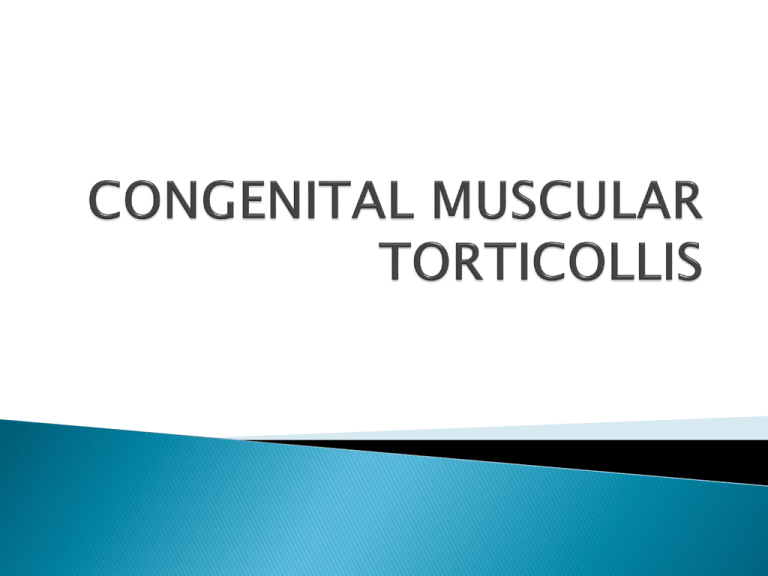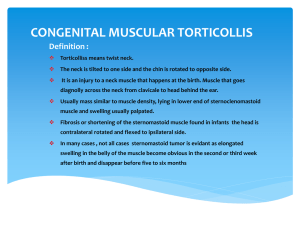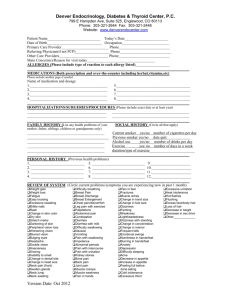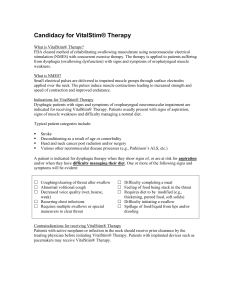torticollis
advertisement

Definition : Torticolliss means twist neck. The neck is tilted to one side and the chin is rotated to opposite side. It is an injury to a neck muscle that happens at the birth. Muscle that goes diagnolly across the neck from clavicale to head behind the ear. Usually mass similar to muscle density, lying in lower end of sternoclenomastoid muscle and swelling usually palpated. Fibrosis or shortening of the sternomastoid muscle found in infants the head is contralateral rotated and flexed to ipsilateral side. In many cases , not all cases sternomastoid tumor is evidant as elongated swelling in the belly of the muscle become obvious in the second or third week after birth and disappear before five to six months Symptoms: Head positioned in the characteristic fashion - The head is tilted toward the affected side - The chin is turned away from the affected side - The child looks away from the affected side - Parents usually notice that baby does not look in one particular direction - Neck Mass is usually noticed soon after birth and may be not found after several weeks after birth when infant neck begins elongate. Etiology: The cause of torticollis is unknown, there are several theories , the most advanced one is that ; Intrauterine mal positioning of the neck with resultant local ischemia of died sternomastoid. After breech delivery. Hemi atlas, rare congenital anomaly of formation of the first cervical vertebra may cause progressive torticollis. Injury to the neck during delivery Intrauterine pressure on the neck due to positioning in the womb Trauma to sternomastoid lead to loss of blood supply to muscle fibrosis Haemorrhage , swelling and degeneration of the muscle fibres Abnormality of blood supply to the fetus lead to scar formation of sternomastoid muscles Clinical features: Deformity does not become apparent until the child is 3 or 4 years old During growth the normal sternomastoid gradually elongated discrepancy becomes more obvious. On the affected side, The mastoid process grow near to sternal notch and ear becomes lower and forward Sternomastoid tendon become tight and cord like restrict the movements away from the affected side Secondary facial deformities may occur. Pathology: Injury of the muscle ussually occur during birth by stretching of the muscle Sever stretching tearing& bleeding into muscle. Bleeding and swelling lead to scar formation replace muscle fibers lead to deformity. Fibrosis of sternomastoid may present with or without tumor Symptoms: Tilting of the head to the affcted side& rotation the chin to the opposite side. Swelling in the sternocledomatoid muscle on one side Flattening on one side of the face in sever untrated cases Limited ROM in neck muscles Physical Therapy management: A)Evaluation History: trauma, pain, birth history Position of the head in relation to trunk and limbs Presence and the extent of the sternomastoid tumour is palpated PROM of the neck is performed in all directions, ARROM is tested by using attracting toy Apparent pain on movement or on palpation of tumour The degree of facial and cranial asymmetery is assessed by turning head to mid line position Asymmetrical or abnormal reflex activities should be tested(ASTNR, moro ,grasp reflex) Follow Up recovery of tumour by measuring its size by tape measurement Goals: prevent development of contracture Stretch tight muscles Strength the antagonist muscles including contralateral sternomastoid and neck muscles Prevent delay of normal neck activities Encourage normal posture Facilitate normal righting reactions P.T modalities: Ice, ultrasound, massage and stretching are all effective in reducing spasm. Instructions in posture and resting positions are helpful in limiting degree of distress and spasm Baby position: The baby is placed on a padded table in supine with affected side away from therapist Grasp : one hand fixing the shoulder of the baby allowing the head to side flexion to perform stretch Stretch for ten seconds with relaxation for ten seconds repeated for several times in side bending towards the sound side Followed by head rotation towards the sound side followed by rotation to affected side The stretch should be gradually and therapist grasp should be gentle not harmful Another method of Stretching: The baby is resting on therapist arms in side lying position with the same way of stretching procedure. Active exercises: After stretching, therapist should encourage the child to active correction and full ROM of head and neck muscles As the head control develop, Facilitate head righting to improve head side bending and rotation, facilitate righting by using ball with baby supine or prone position Home routine: Explain to parent not only the purpose of the treatment but also the practical ways of making treatment at home The mother should be taught how to stretch the sternomastoid muscle and how to facilitate the movements The baby should be encouraged to turn head away from abnormal posture. The baby should be encouraged to sleep on one side rather than supine Splinting: Cap and jacket Splint to keep the baby head in full stretched position , not preferable because if weaning it for long time, it hinder the active correction of neck muscles Surgical treatment: Tenotomy of sternomastoid above the attachment of the clavicle if the contracture persists treatment Post operative PT: Immediately after surgery: the child lies without pillow, sand bag prevent head from returning to the asymmetrical position, Cap jacket is advised until the child can maintain head in midline position Stretching and active correction are started after 36 hours from surgery Facilitate normal righting reactions





